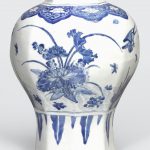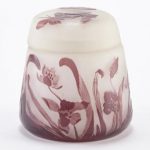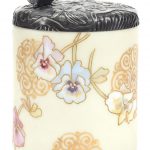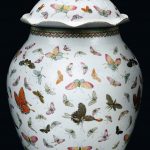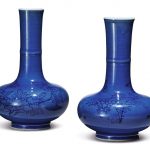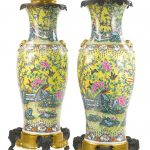A jar is a rigid, cylindrical or slightly conical container, typically made of glass, ceramic, or plastic, with a wide mouth or opening that can be closed with a lid, screw cap, lug cap, cork stopper, roll-on cap, crimp-on cap, press-on cap, plastic shrink, heat sealed lidding film, an inner seal, a Tamper-evident band, or other suitable means.
Jars can be used to hold solids too large to be removed from, or liquids too viscous to be poured through, a bottle’s neck; these may be foods, cosmetics, medications, or chemicals. Glass jars—among which the most popular is the mason jar—can be used for storing and preserving items as diverse as jam, pickled gherkin, other pickles, marmalade, sun-dried tomatoes, olives, jalapeño peppers, chutneys, pickled eggs, honey, and many others. Reference: Wikipedia
Below are some examples, information and price guide to jars with butterflies in their design including a Galle cameo glass jar and a famille rose butterfly jar.
Spherical Jar with Flowers in a Basket A covered jar in the shape of a globe on a pedestal. The decoration evokes a three-dimensional illusion of a net bag, tied with tassels at the top, swelling and overflowing with of a variety of flowers from different seasons (chrysanthemums, peonies, morning glories, lilies, etc.) The inside surface of the lid is enameled with flowers, leaves and butterflies. The lid has a gilt bronze finial in the shape of a closed chrysanthemum. The enamel is translucent and semi-opaque.
Reference: The Walters Art Museum
A BLUE AND WHITE OCTAGONAL JAR Chongzhen Painted with a saw-tooth band along the rim and a lappet band with lotus flowers in reserve along the shoulder, birds and butterflies flying above lotus and water plants in bloom amid rocks along a water course that encircles the convex walls above a border of inverted stiff leaves, the lustrous glaze stopping unevenly above the flat and unglazed base. 11 7/8in (30cm) high
Sold for US$ 4,075 (£ 3,268) inc. premium at Bonham’s in 2019
Galle Acid Etched Cameo Glass Jar Circa 1900 Of circular form, in plum over frosted colorless glass, decorated on the body with blossoms and on the cover with three butterflies, cover and body cameo signed Galle. Height 3 3/4 inches.
Sold for $1,000 (includes buyer’s premium) at Doyle in 2015
Covered Jar, Unmarked Crown Milano; 6″; Yellow Background with Stylized Gold Medallion Highlights, Colorful Pansy Decor, Embossed Floral Silverplate Lid with Butterfly Finial
Sold for $275 at Woody Auction LLC in 2020
A FAMILLE-ROSE ‘BUTTERFLY’ JAR AND COVER MARK AND PERIOD OF GUANGXU of ovoid form with a tapered rim, painted overall with a rabble of butterflies of varying sizes and colours, all meticulously drawn with minute detailing in pastels of famille-rose enamels fluttering around four evenly spaced larger specimens, all between a row of lime-green and pink lappets at the base and a collar of green-ground ruyi around the rim, the domed cover modelled in the form of a lotus pad with undulating rim and a spiral knob, similarly decorated with fluttering butterflies, the base inscribed in underglaze blue with a six-character reign mark 40 cm., 15 3/4 in.
Sold for 625,000 HKD at Sothebys in 2013
Storage jar of porcelain, decorated with flowers and butterflies in copper red pigment under clear glaze
This storage jar dates to the late Cboson Period (1392-1910) and is decorated with a motif of flowers and butterflies in under-glaze copper red. Almost all extant examples of copper-decorated white porcelain date from the eighteenth century or later. Because of the greyish-white glaze and faint blue or green hue, it is believed to have been made in a local kiln. The technique of decorating ceramics with copper-red developed in Korea in the 12th century when it was used on celadon wares, but it was virtually unused in the making of white porcelain until the mid 18th century. Because of the unpredictability of copper, the colour would sometimes blur or turn green or brown after high-temperature firing.
Reference: © Victoria and Albert Museum


